
Spanish moss is an epiphytic flowering plant that often grows upon large trees in tropical and subtropical climates. It is native to much of Mexico, Bermuda, the Bahamas, Central America, South America, the Southern United States, and West Indies. It has been naturalized in Queensland (Australia). It is known as "grandpa's beard" in French Polynesia.

Tillandsia recurvata, commonly known as small ballmoss or ball moss, is a flowering plant in the family Bromeliaceae that grows upon larger host plants. It grows well in areas with low light, little airflow, and high humidity, which is commonly provided by southern shade trees, often the southern live oak. It is not a parasite like mistletoe, but an epiphyte like its relative Spanish moss.
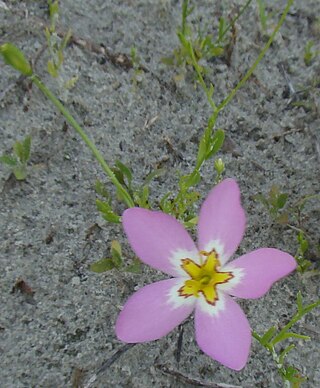
Sabatia stellaris, with the common names rose of Plymouth, marsh pink, salt-marsh pink, and sea-pink; is a species of Sabatia. It has the synonym Sabatia maculata (Benth.) Benth. & Hook.f., Sabatia palmeri Gray, Sabatia purpusii Brandeg., Sabatia simulata Britt.).

Tillandsia bartramii, commonly known as Bartram's airplant, is a species of flowering plant in the bromeliad family. It is native to Florida, South Carolina and southern Georgia in the United States as well as Guatemala and Mexico. The name honours William Bartram (1739–1823), an early Florida naturalist.

Tillandsia balbisiana, common name northern needleleaf, is a species of bromeliad in the genus Tillandsia. This species in native to Mexico, Central America, Colombia, Venezuela, the West Indies, and Florida.

Tillandsia bulbosa, the bulbous airplant, is a species of flowering plant in the genus Tillandsia. It is widespread across Central America, the West Indies, southern Mexico, and northern and eastern South America.
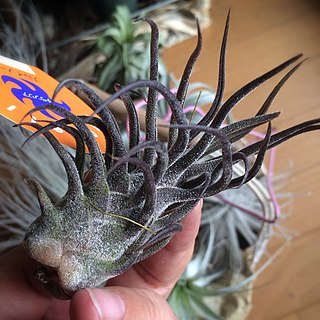
Tillandsia pruinosa, is a species of flowering plant in the family Bromeliaceae. It is commonly known as the fuzzywuzzy airplant. This species is native to northern South America, Central America, southern Mexico, the West Indies and Florida.

Tillandsia tenuifolia, the narrowleaf airplant, is a species in the genus Tillandsia. This species is widespread across much of South America and the Caribbean islands.

Tillandsia fasciculata, commonly known as the giant airplant, giant wild pine, or cardinal airplant, is a species of bromeliad that is native to Central America, Mexico, the West Indies, northern South America, and the southeastern United States. Within the United States, this airplant is at risk of extirpation from the Mexican bromeliad weevil, Metamasius callizona. A related plant, Tillandsia utriculata, sometimes called the "wild pine", is endemic to the same areas.
Tillandsia festucoides, commonly known as the fescue airplant, is a species of bromeliad that is native to the Greater Antilles, Mexico, the Cayman Islands, and Central America.
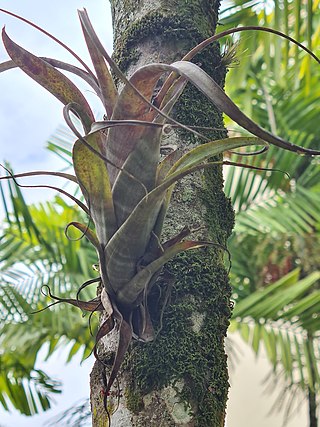
Tillandsia flexuosa, the twisted airplant, is a species of bromeliad in the genus Tillandsia. This species is native to Central America, southeastern Mexico, northern South America and the United States (Florida).

Tillandsia ionantha, the air plant, is a species of plant in the genus Tillandsia. This species is native to Central America and Mexico. It is also reportedly naturalized in Broward County, Florida.
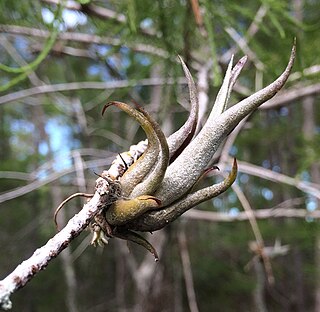
Tillandsia paucifolia, the potbelly airplant, is a species of bromeliad in the genus Tillandsia. This species is native to Central America, central and southern Mexico, Venezuela, Colombia, the West Indies, and Florida.

Tillandsia utriculata, commonly known as the spreading airplant, the giant airplant, or wild pine is a species of bromeliad that is native to Florida and Georgia in the United States, the Caribbean, southern and eastern Mexico, Central America, and Venezuela.
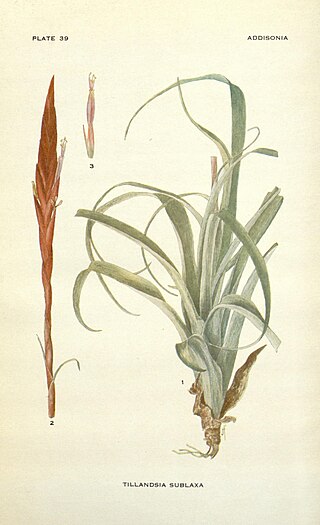
Tillandsia variabilis, the leatherleaf airplant, is a species of bromeliad in the genus Tillandsia. This species is native to Bolivia, Costa Rica, Mexico, Venezuela, Colombia, the West Indies and southern Florida.
Tillandsia ariza-juliae, the wand airplant, is a species in the genus Tillandsia. It is native to the Dominican Republic and Puerto Rico.
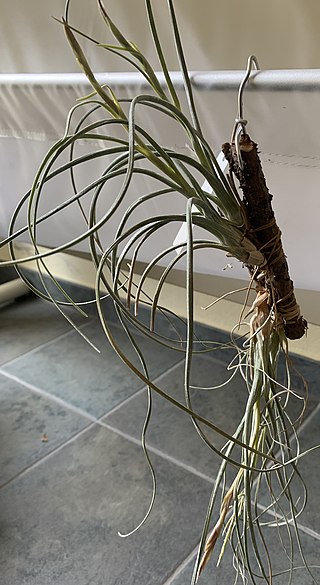
Tillandsia baileyi, commonly known as the reflexed airplant or Bailey's ball moss, is a species of bromeliad that is native to southern Texas in the United States and Tamaulipas in Mexico. It is found along the Gulf of Mexico from Kingsville, Texas to Tampico, Tamaulipas. Preferred host plants for this epiphyte include Southern live oak and Texas ebony.
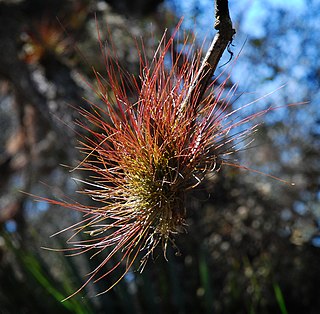
Tillandsia setacea, the southern needleleaf, is a species of flowering plant in the genus Tillandsia. It has a scattered, disjunct distribution in the southeastern United States, northwestern and southern Mexico, Guatemala, the West Indies and the State of Pará in northeastern Brazil.

Symphyotrichum georgianum is a rare species of flowering plant in the Asteraceae, the aster family. Its common name is Georgia aster. It is native to the southeastern United States where it is known from Alabama, Florida, Georgia, North Carolina, and South Carolina. As of 2013, it may be extirpated from the state of Florida.

Solidago latissimifolia, common name Elliott's goldenrod, is North American species of flowering plants in the family Asteraceae. It is native to the Atlantic Coast of the United States and Canada, from Nova Scotia south to Alabama and Florida.

















